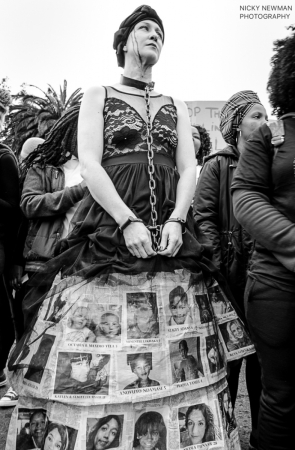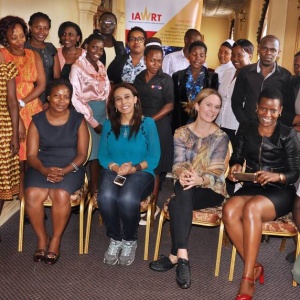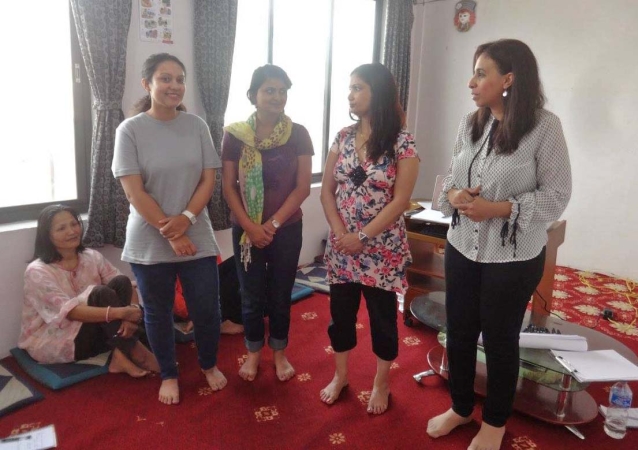Increasingly, risky or dangerous reporting environments for women are not restricted to war zones and sites of civil conflict. It is now well documented that female journalists face far more threats and harassment in the digital or online environment than their male colleagues. In September, the International Media Women’s Foundation and Trollbusters rep[orted in the increasing scale of the issue in Attacks and Harassment: The Impact on Female Journalists and Their Reporting which is available for download from iwmf.org
Many journalists are facing attacks on media freedoms across the world, but women are also facing attacks on their personal reputations which can be devastating to careers in some cultures, along with threats of rape and other gender based online attacks. This has become so commonplace that there is growing agreement on the need for clear policies on supporting and protecting female media workers from online attacks. Of course, the #MeToo movement has been instrumental in making it clear that the starting place for reform is a harassment-free place of work.
In this video, safety trainer Abeer Saady canvasses the views of experts on cyber violence about policies which can protect media women; media editors on workplace initiatives which acknowledge the issues faced by their female workforce and action plans to protect them, and a senior journalist on personal strategies to end the violence which aims to silence women in media.
IAWRT is keen to provide resources for training and workshops on the safety of women journalists and appreciates any comment or feedback, to [email protected].
Interviews conducted by Abeer Saady, video production by Lady Ann Salem.
Personell in order of appearance (from online CV’s)
- Joyce Barnathan, President of the International Center for Journalists (former executive editor, assistant managing editor for Asia regional editor and Hong Kong Bureau Manager for Business Week. Barnathan came to Business Week from Newsweek, where she served as State Department correspondent, Moscow Bureau Chief and Special Projects Correspondent covering presidential elections. As president of the ICFJ since 2006, Joyce Barnathan has helped to develop and oversee a wide variety of high-impact programs at the nexus of quality journalism and technology. Under her leadership, ICFJ helps journalists to tell compelling stories, engage audiences and deepen coverage. Over 34 years, ICFJ has worked with 100,000 participants from 180 countries.
- Emma Alberici Chief Economics Correspondent Australian Broadcasting Corporation, Sydney. Alberici was the presenter of the ABC’s flagship current affairs program, Lateline. and served a term as the ABC’s Europe correspondent. She has worked as a reporter for the ABC’s The 7.30 Report and began her career at the Herald Sun Newspaper and as a reporter and producer at Australia’s commercial TV Nine Network.
- Leyla Boulton Editor of Special reports and an Executive Editor of the Financial Times. Since joining the newspaper as a correspondent in Moscow in 1990, Leyla has been FT correspondent in Turkey, environment correspondent, as well as a news editor and web pioneer. She takes a keen interest in gender equality at work since she began reporting on this topic and pressing for change within her own organisation a decade ago.
- Gunnar Falck is the managing editor at Västerbottens-Kuriren in Umeå, Sweden. After completing his studies at the University of Journalism in Stockholm in 1980, he worked at Nerikes Allehanda in Örebro and Norra Västerbotten in Skellefteå, before joining Västerbottens-Kuriren in 1982. Gunnar has worked as a reporter, as a sportswriter, head of the sports department, night editor and since 2002 as the managing editor. Gunnar was put in charge the same year that the newspaper decided to start a project aimed at increasing the number of women as the main character in the news and in stories. The project was quickly made a permanent part of the daily operation and is still ongoing. Gunnar has written a chapter about this in the Swedish national report Count on women as a part of the Global Media Monitoring Project 2015, and in English in Making change: Nordic examples of working towards gender equality in media.
- Doctor Anastasia Powell, Associate Professor in Criminology & Justice Studies at RMIT University, Melbourne, Australia, currently a member of the editorial board of the international journal Crime, Media, Culture, and serves on the board of directors of Our Watch, Australia’s national organisation for the prevention of violence against women and their children. Her research has specialised in sexual and intimate partner violence, as well as emerging forms of technology- facilitated violence against women. Anastasia has published widely in these fields, including the book Sexual Violence in a Digital Age (2017, Palgrave). From 2013-2015, Dr. Powell was lead Chief Investigator on an ARC Discovery Project with Dr Henry, titled Technology-facilitated sexual violence and harassment. The project examined the ways in which technologies (including mobile phones, video recordings, online spaces, social media) are being used in connection with sexual violence and harassment against women.
IAWRT acknowledges – and there are many examples around the globe which we have commented on in films and publications – that online attacks are not always random opportunities offered by the anonymity of the internet but often carefully orchestrated and controlled by particular political interests.
India’s Swati Chaturvedi responded to vicious online harassment campaigns by using journalistic weapons. According to Reporters Without Borders (RSF) which has nominated her for one of its 2018 Press Freedom Awards, she began investigating the “IT cell” within the Bharatiya Janata Party, the Hindu nationalist party led by Prime Minister Narendra Modi, “which is notorious for keeping an army of angry trolls.”
That lead to the publication of a book I am a Troll: Inside the Secret World of the BJP’s Digital Army. The RSF says, “in retaliation for her reporting, Swati Chaturvedi is now even more exposed to calls for revenge by social media trolls.”
In Finland the courts have upheld the right of journalist Jessikka Aro, a reporter for the Finnish national broadcaster YLE, to be safe from the harasment and hate crime which she suffered when she began investigating Russian propoganda troll factories. The court has sentenced Ilja Janitski, nthe founder of a pro-Russian website, MV-Lehti to 22 months in prison on charges of defamation and negligence. Janitski and two other Finish journalists were ordered to pay 136,000 euros compensation. The BBC has a good explanation of the story here.
There is no ‘one size fits all’ response to cyber violence and IAWRT is committed to sharing any safety strategies which may keep media women safe to continue doing their important work.
Take care of personal safety before your equipment
By Sarah Nakibuuka Bakehena
The IAWRT Uganda Chapter held a ‘Safety Training Workshop on safety measures and protection for female journalists
The training was conducted by Abeer Saady the Vice President of IAWRT International on 21 November 2017 at the Grand Imperial Hotel Kampala. The workshop was aimed particulalry at those who report in conflict zones
She cautioned journalists to take care of their personal safety before considering their equipment because their life is much more important. Journalists were also told to take the precaution of knowing how to carry out first aid, both for themselves and their colleagues. While they were advised to avoid unnecessary risks, they need to be able to deal with any injuries received on the job.
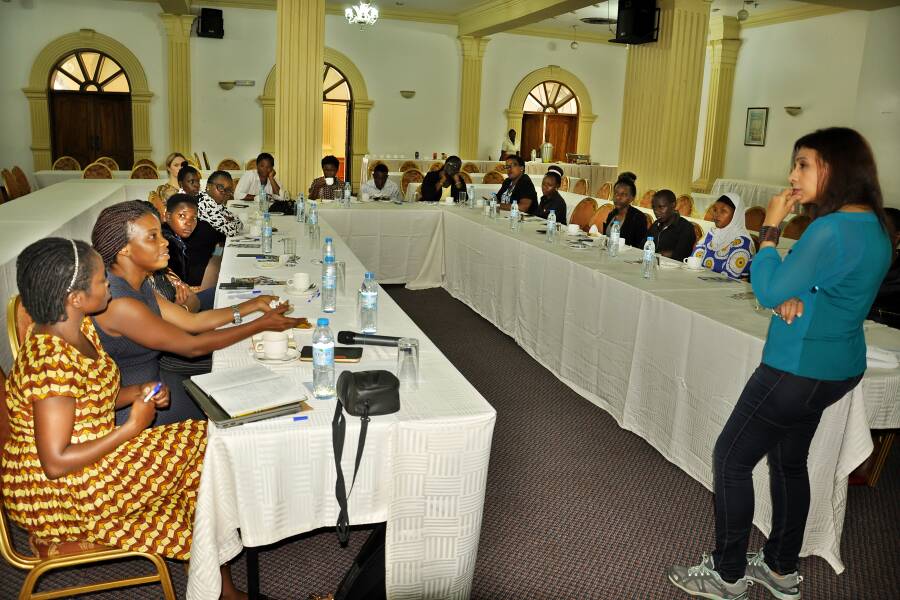 Abeer also called on journalists to always assess risk by identifying the threats, estimating the level of risk, and managing the risk through a security plan which involves: Preparation (risk assessment and gender related preparation); Travel to the site (mobility preparations: transportation, times, and routes); Implementation of mission (situational awareness) and returning home.
Abeer also called on journalists to always assess risk by identifying the threats, estimating the level of risk, and managing the risk through a security plan which involves: Preparation (risk assessment and gender related preparation); Travel to the site (mobility preparations: transportation, times, and routes); Implementation of mission (situational awareness) and returning home.
Abeer called on journalists to consider the following ethical questions as they develop stories: Why am I publishing the story? Will someone get hurt by my story? Can I find alternatives? Can I reduce the harm? Can I defend my decision? These are key to avoiding risk.
Ms. Sarah Nakibuuka Bakehena Secretary of IAWRT noted that a number of journalists, especially female journalists, receive lots of threats but never report them – something that puts their lifes at risk. She called on the media in Uganda to always report any cases of threat to the police and to work with IAWRT Uganda to enable them seek legal support.
She called on women’s organizations and law firms to support an initiative to ensure that all journalists benefit from such legal support.
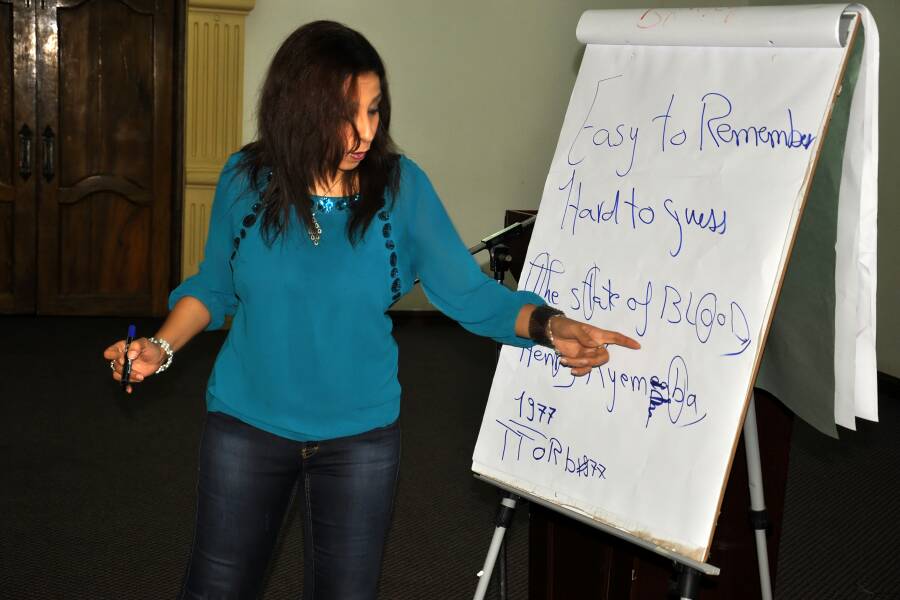
 The workshop was attended by IAWRT Members in Uganda from various media organisations including: Radio One, Akabozi Radio, NTV Uganda, Impact FM, Vision Group, (Bukedde FM and Urban Television), Ndejje University Kampala Mass Communication Department, Salt FM, Human Rights Network for Journalists (HRNJ), KFM and Dembe FM, CBS FM and Mama FM. Ms. first name? Marte H. Hoiby Department of Journalism and Media Studies Oslo and Akershus University College (HiOA) and also a member of IAWRT Norway also attended the training.
The workshop was attended by IAWRT Members in Uganda from various media organisations including: Radio One, Akabozi Radio, NTV Uganda, Impact FM, Vision Group, (Bukedde FM and Urban Television), Ndejje University Kampala Mass Communication Department, Salt FM, Human Rights Network for Journalists (HRNJ), KFM and Dembe FM, CBS FM and Mama FM. Ms. first name? Marte H. Hoiby Department of Journalism and Media Studies Oslo and Akershus University College (HiOA) and also a member of IAWRT Norway also attended the training.
Safety for Women Media Workers
Egyptian journalist, and IAWRT board member, Abeer Saady, has delivered safety training to journalists working in hostile areas in numerous Middle Eastern countries over many years. She has shared her long experience and skills in safety training at IAWRT gatherings in India and Nepal and most recently at the Johannesburg regional conference in South Africa in October 2016.
By Noxolo P. Mshweshwe
As a female in journalism, the Johannesburg workshop provided an opportunity to discover the best ways to deal with a wide range of safety concerns. A wealth of knowledge was shared, and it was very refreshing to hear the different experiences of all the ladies who participated in the workshop.
Abeer presented us with a visual representation of a technique to assess our safety situation.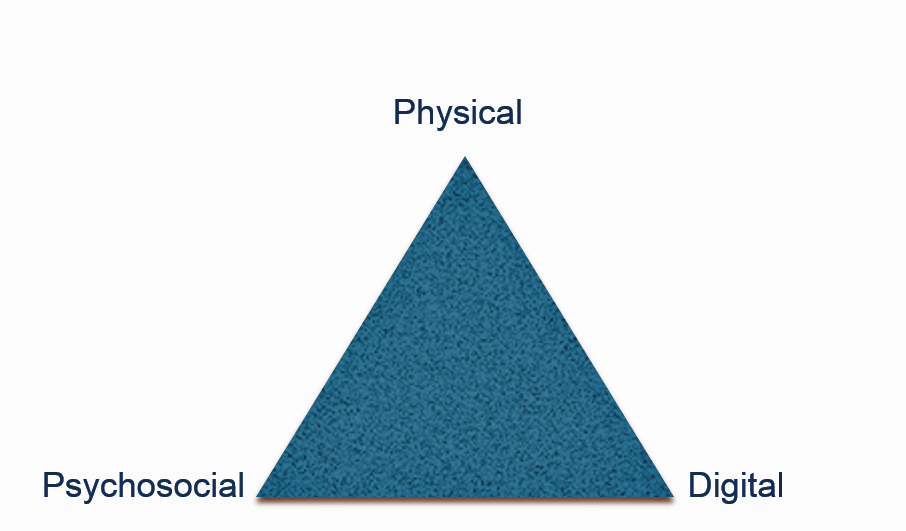 The triangle, pictured right, was designed to show how we must thoroughly assess any situation, to determine how we can behave in the safest way:
The triangle, pictured right, was designed to show how we must thoroughly assess any situation, to determine how we can behave in the safest way:
Physical Safety
This relates to the safety of one’s person. For example, if you are traveling abroad, have you made provision for things like any medical concerns, such as contracting a virus. In addition, have you given thought to how you are going to be traveling; where you will be; and do you have plans in place for unexpected happenings, e.g. what you would do if you were involved in a car accident?
As part of physical safety, we also had a lengthy discussion about the type of attire that one should wear. It was shocking to learn that in certain countries female journalists are intimidated by being stripped naked so that they don’t get to cover the story that they are after. Attire is a part of profile management – both physical and digital – which Abeer says is a crucial element of a female journalist’s safety.
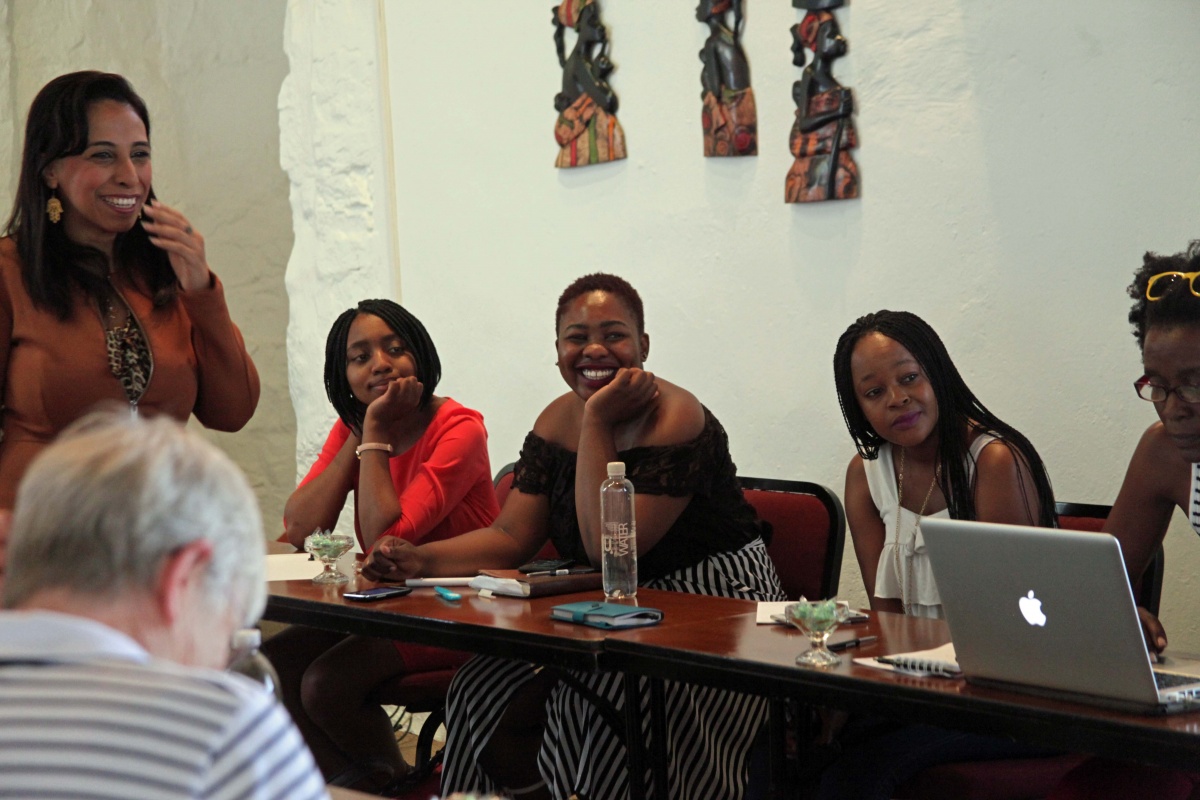 One of the suggestions was that a jumpsuit type outfit would prove to be a safe option female journalists, particularly in a crowd, just in case they happened to find themselves in that situation. We all laughed in unison at the realisation that that would make it very interesting when the time came to visit the bathroom!
One of the suggestions was that a jumpsuit type outfit would prove to be a safe option female journalists, particularly in a crowd, just in case they happened to find themselves in that situation. We all laughed in unison at the realisation that that would make it very interesting when the time came to visit the bathroom!
It was also very interesting to learn that even though the female body is targeted for intimidation, (hate speech, including threats of rape or physical harassment, as well as defamation of a sexual nature which can destry careers in some local contexts) it can also be used to enhance safety.
In some countries, female sex workers have been paid to create a human chain as a buffer between Police and journalists. If the Police advance to stop the journalists or to confiscate their footage; the female sex workers strip naked and the police, who are predominantly male, stop dead in their tracks and cannot proceed any further. This is either because of the shame of female nakeness in some countries or the potential that security forces will be accused of having stripped female protesters.
Psychosocial Fitness
This relates to matters around the support structures which you have, to prepare you for the reality on the ground, wherever you are. For this purpose, our brilliant facilitator, Abeer Saady made the simple yet effective suggestion of having a ‘circle of trust’ amongst peers and colleagues.
These would be the people that you would tell where you are going, where you are staying, how long you will be away etc. From within this circle, you would also choose someone to tell when and where you’re going to meet sources; as that is a very sensitive matter for both you as the journalist as well as for the safely of the source itself. This inner circle would also act as an independent monitor of your psychological well-being; effectively they ask the question, are you OK?
Another important element towards avoiding anxiety would be for you to forge relationships with the local journalists, in the place you are traveling to. They are likely to have a much better knowledge of the location or locations where you will be and they can assist with you in creating maps of where everything is located. In addition, they will also be the best to advise on various possible rendezvous points and where the safest place to go might be, if the situation escalates and the safest option is to leave the scene completely.
Digital safety
This was also a thrilling element of the safety triangle. In this technological era where we are all on at least one social media platform, we were reminded to not disregard how checking in to a certain venue, stating which airports you’re traveling through, or which hotels you stay in, is a very serious security threat.
It is on social media platforms that we have and manage our profiles, and whilst what a ‘badged’ journalist’s reports may make her a target to some interest groups, there are sensible ways to manage our profiles which make us a smaller target.
No story is worth your life
We had a lengthy discussion around when it is time for a journalist to leave the scene completely! Our facilitator was very clear about no story being worth your life. She even shared with us that she had her jaw broken and had to have multiple surgical procedures to correct that injury. Abeer Saady says there are situations where it is best to protect yourself by allowing your equipment to be taken.
This also lead us smoothly into discussion on what type of equipment is most appropriate for which situations and how as a journalist you may best use that equipment so that you remain as far below the radar as possible.
I recall that it was at this stage that it became most apparent to all of us that the triangle is crucial and not one element of it is more important than the other … They are all crucial.
One of the workshop guests shared her traumatic experience of getting into a physical altercation with airport security, as they wanted to confiscate her technical equipment. We used her experience as a case study.
As we were all listening attentively we realized that her situation was a mix of physical safety and psychosocial safety. She had realized very quickly that the situation was escalating and had given a clear instruction to a male member of her team to walk out with all the equipment. The male colleague resisted and by the time he wanted to leave, it was too late. He then handed over the camera, which we were advised was the best thing to do, but as the owner of the camera, the woman resisted -leading to the altercation. She managed to save the camera and then the security proceeded to go for her light. It was at this stage that she, production light in hand, was physically picked up by the security in order to remove her. It was an essential lesson in the sensitivities required when dealing with gender relations in your team.
The Emergency Grab Bag
The last activity for the day was what was called a ‘grab bag’ exercise. For this we were broken up into two groups and we had to create a scenario in which we could demonstrate that we could now apply all the things that we had learned.
The grab bag is meant to be the one resource that you may pick and take with you in an emergency. We thought it would be simple enough, because our facilitator had done such a great job with the knowledge transfer. We soon realized that it wasn’t as simple as it looked.
Between traveling documents and credentials, we also looked at having sanitary towels and medical equipment. In addition, having enough to keep warm but not so much that your grab bag become a pull suitcase… It was a process to understand what is a necessity and what is just what we want.
Perhaps the most valuable learning curve of that exercise was the situational assessment that we went through. Looking at both scenarios we realized just how many players were in each scenario and therefore all the mindfulness with which we had to approach each and every situation.
Noxolo P. Mshweshwe is a volunteer editor and founder of www.kaspeda .com an African township encyclopedia. http://www.kasipedia.com/about-us/
Gallery: September 10, 2016 IAWRT Nepal organized Security Training by Abeer Saady, The training was targeted for women journalists.


